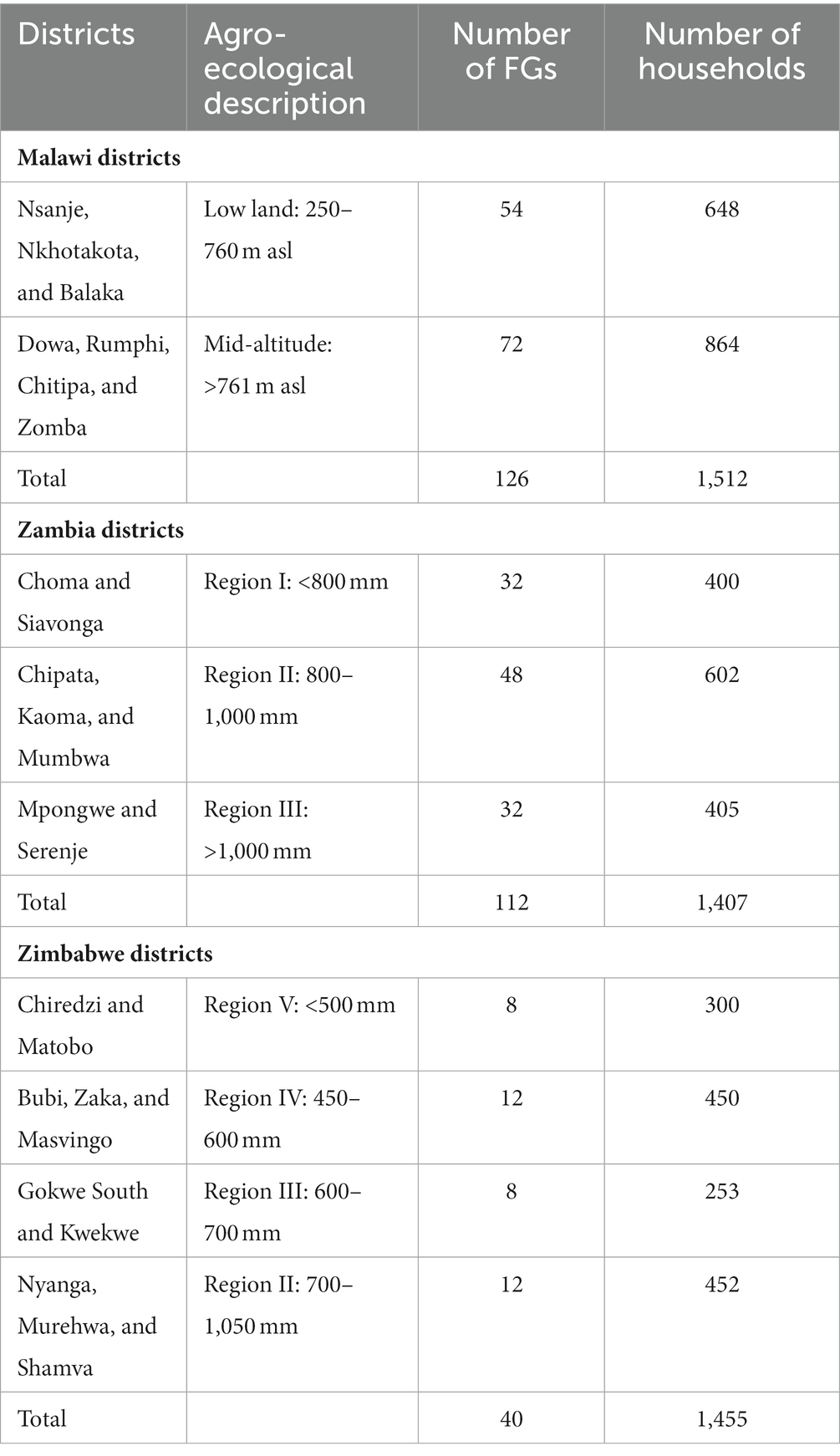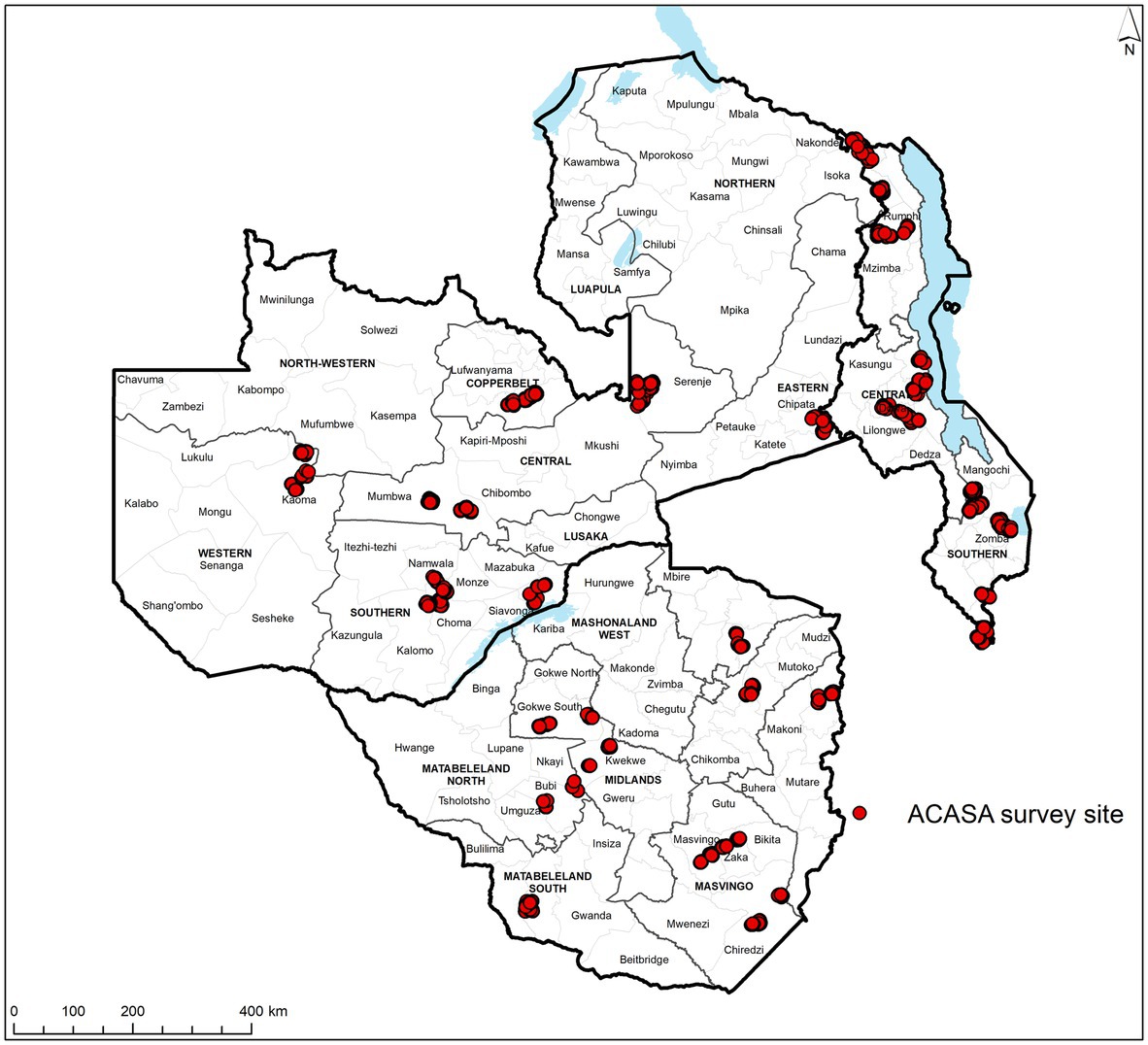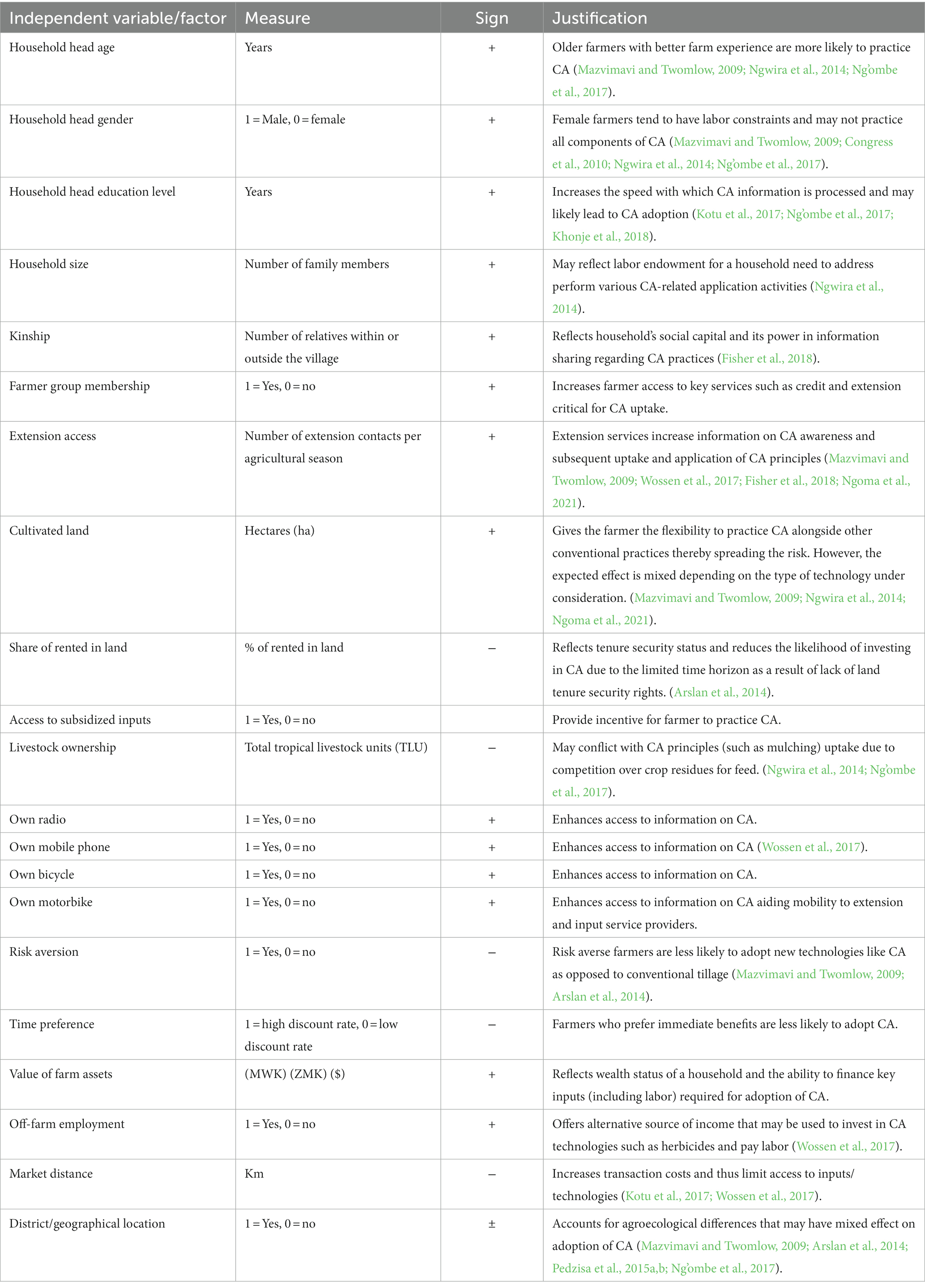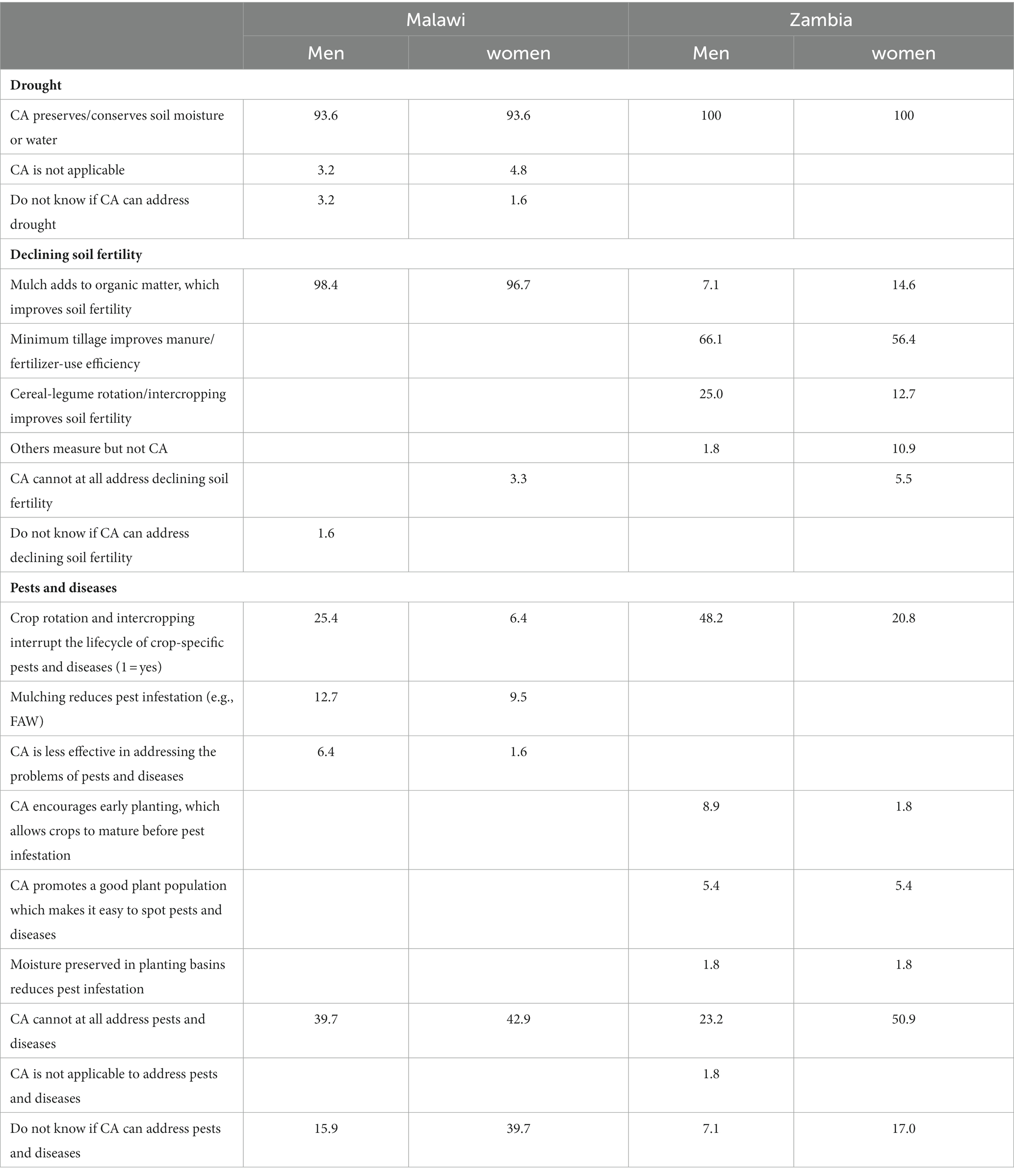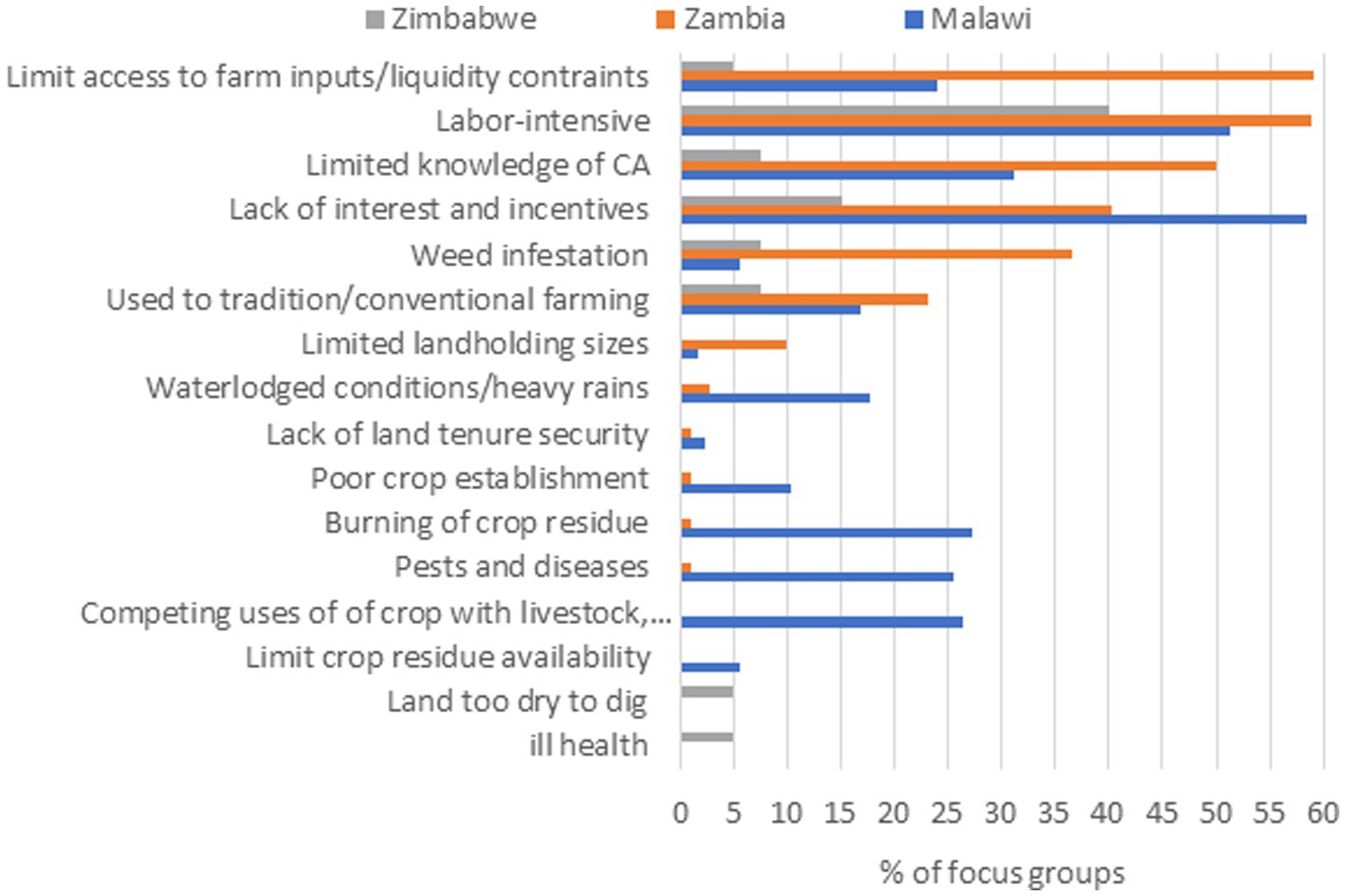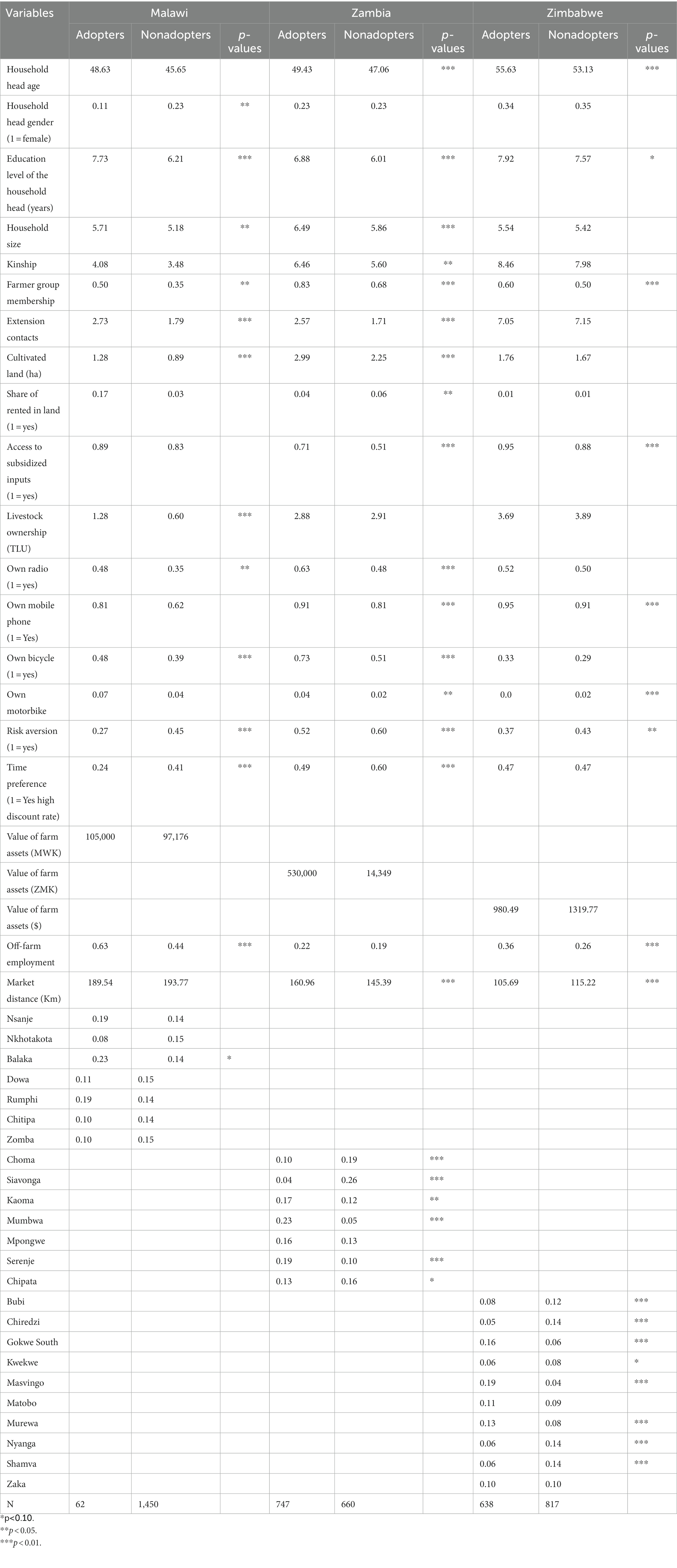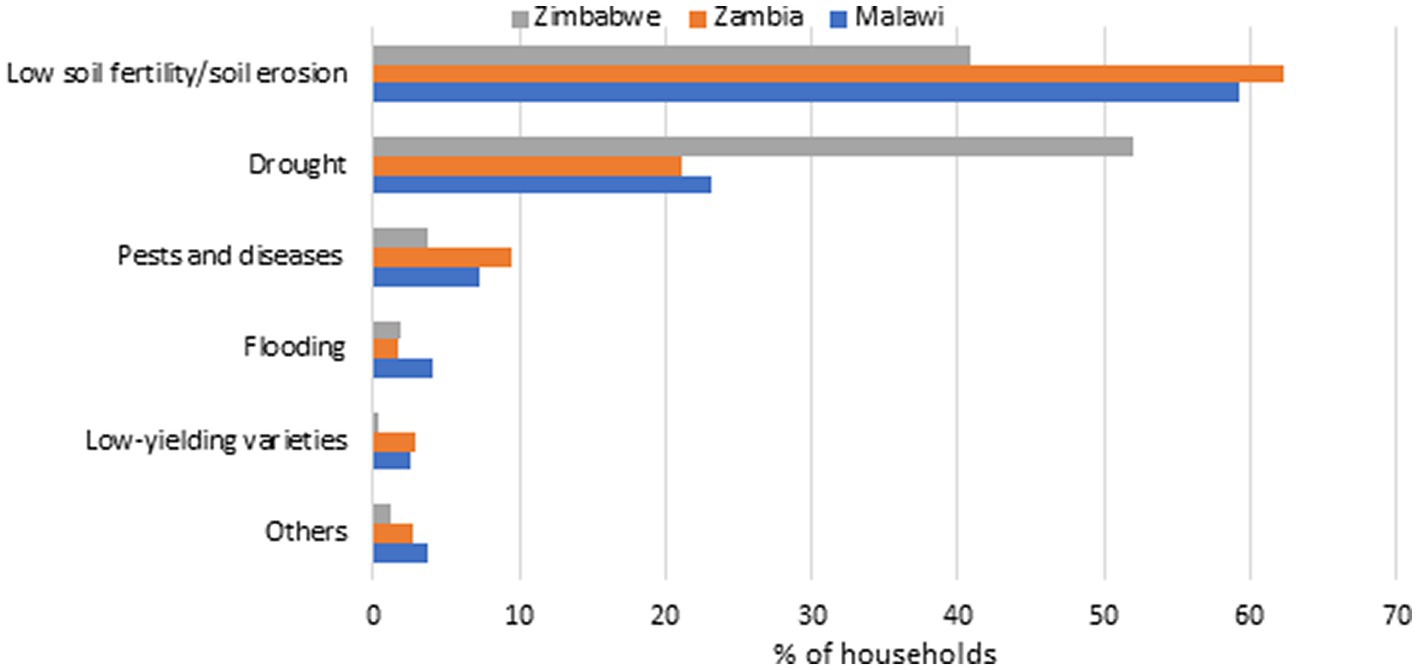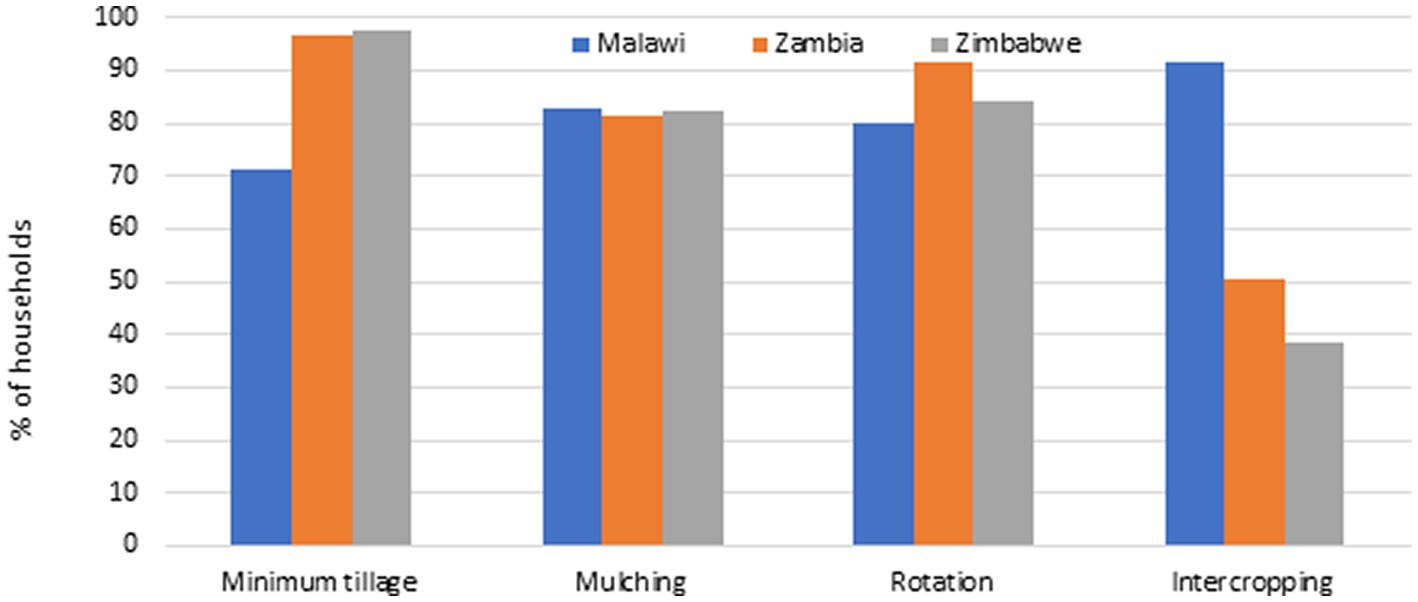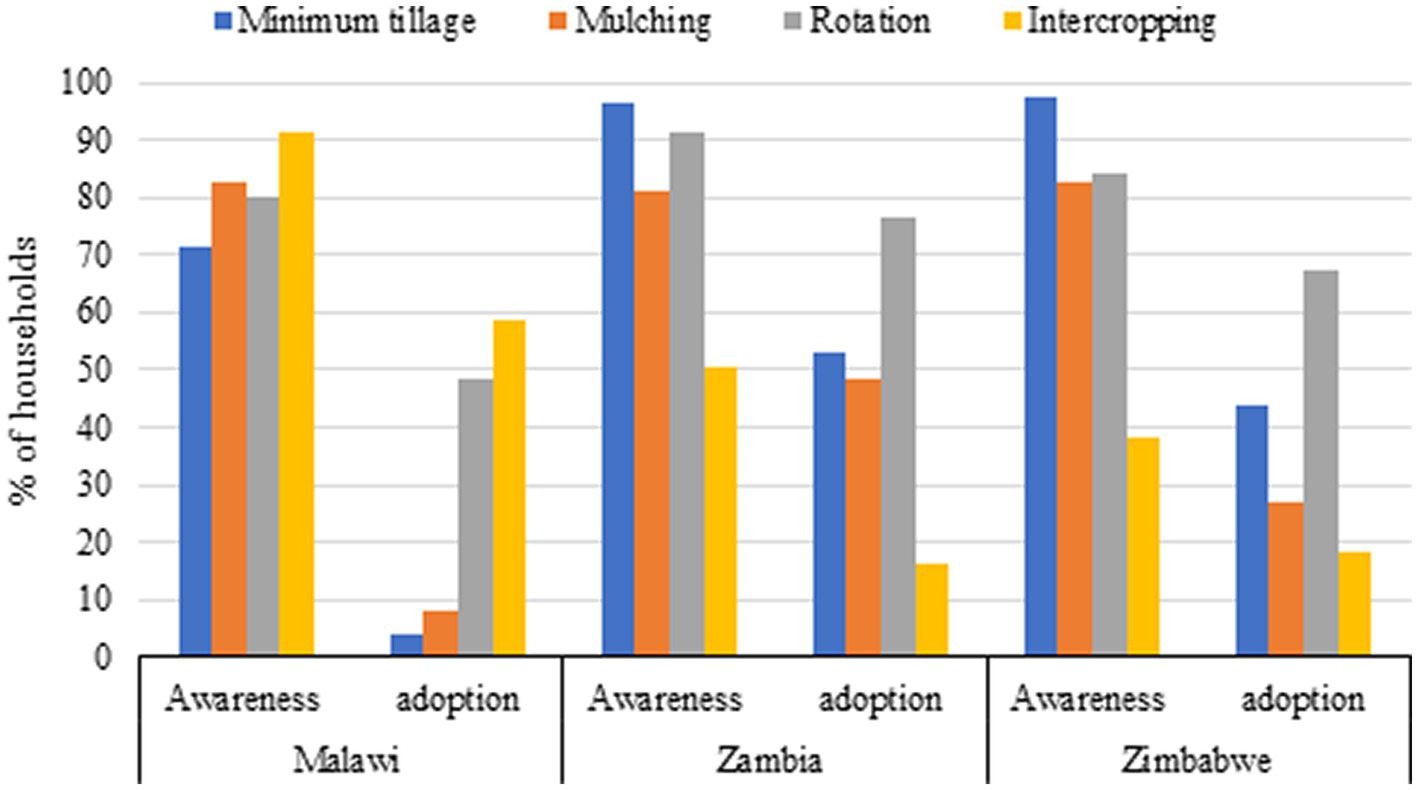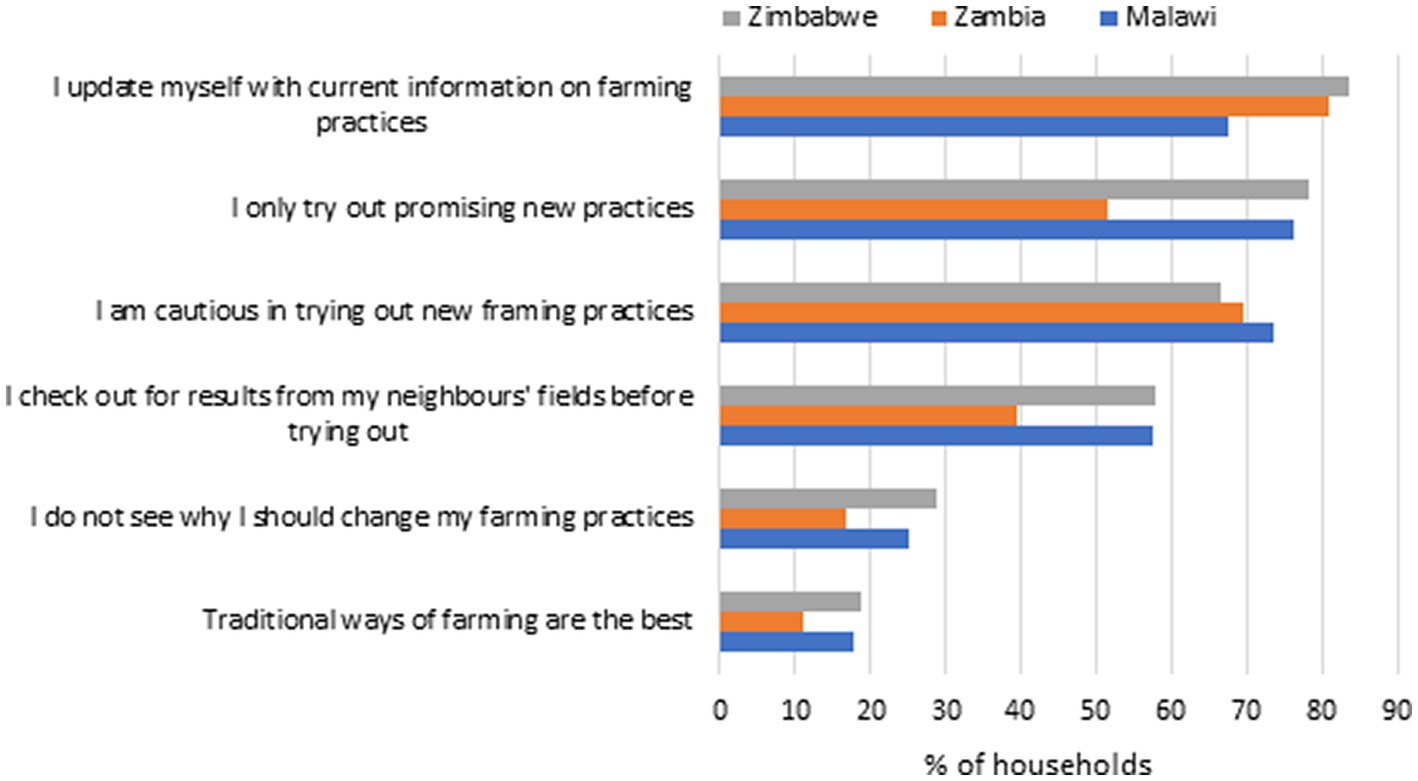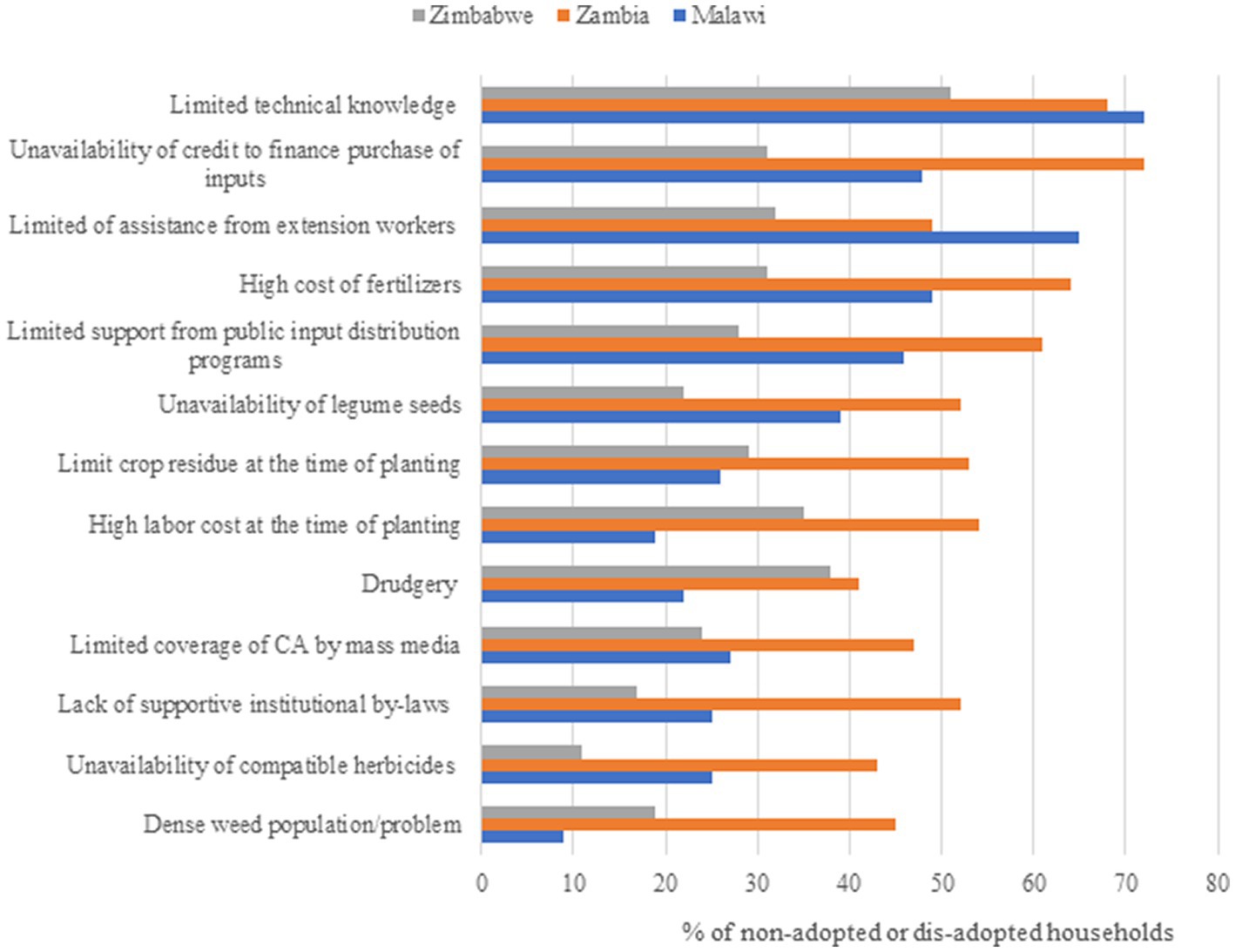- 1Department of Socioeconomics and Agribusiness, International Institute of Tropical Agriculture, Lilongwe, Malawi
- 2Department of Socioeconomics and Agribusiness, International Institute of Tropical Agriculture, Nairobi, Kenya
- 3Department of Sustainable Agri-Food Systems, International Maize and Wheat Improvement Centre (CIMMYT), Harare, Zimbabwe
- 4Department of Sustainable Agri-Food Systems, The International Maize and Wheat Improvement Center (CIMMYT), Nairobi, Kenya
- 5Department Plant Health and Nutrition, International Institute of Tropical Agriculture (Zambia), Lusaka, Zambia
In southern Africa, conservation agriculture (CA) has been promoted to address low agricultural productivity, food insecurity, and land degradation. However, despite significant experimental evidence on the agronomic and economic benefits of CA and large scale investments by the donor community and national governments, adoption rates among smallholders remain below expectation. The main objective of this research project was thus to investigate why previous efforts and investments to scale CA technologies and practices in southern Africa have not led to widespread adoption. The paper applies a multivariate probit model and other methods to survey data from 4,373 households and 278 focus groups to identify the drivers and barriers of CA adoption in Malawi, Zambia, and Zimbabwe. The results show that declining soil fertility is a major constraint to maize production in Zambia and Malawi, and drought/heat is more pronounced in Zimbabwe. We also find gaps between (a) awareness and adoption, (b) training and adoption, and (c) demonstration and adoption rates of CA practices in all three countries. The gaps are much bigger between awareness and adoption and much smaller between hosting demonstration and adoption, suggesting that much of the awareness of CA practices has not translated to greater adoption. Training and demonstrations are better conduits to enhance adoption than mere awareness creation. Therefore, demonstrating the applications and benefits of CA practices is critical for promoting CA practices in all countries. Besides, greater adoption of CA practices requires enhancing farmers’ access to inputs, addressing drudgery associated with CA implementation, enhancing farmers’ technical know-how, and enacting and enforcing community bylaws regarding livestock grazing and wildfires. The paper concludes by discussing the implications for policy and investments in CA promotion.
1. Introduction
Poor soil fertility and drought are the major constraints to maize production in southern Africa. According to Omuto and Vargas (2018), there is a high prevalence of soil degradation linked to inadequate soil fertility management, fragile soils, steep slopes, limited extension services, low level of awareness and poor adoption of soil conservation technologies, erratic and high rainfall intensities, and little soil cover. Moreover, the effects of climate change and population growth further threaten the livelihoods of millions of farmers in the region (Lobell et al., 2008; Sanginga and Woomer, 2009). The increased threats of climate change, soil fertility decline, and pressure on food and nutrition security require transforming the current farming systems into more robust ones based on good agronomy and conservation agriculture (CA)1 (Giller et al., 2015; Thierfelder et al., 2017). Improved seeds and mineral fertilizers alone are insufficient: improved maize and legume varieties and improved and more sustainable land-use practices—particularly those that increase water and nutrient capture—are imperative. Adaptation to a changing climate requires new and innovative solutions at the field, farm, and community levels; and at different intensities (Cairns et al., 2012). CA has increasingly been promoted in southern Africa to address many problems associated with conventional agriculture, including soil degradation, high labor demands, and drought. As a practice, CA addresses low soil fertility, moisture deficits, and low management standards through the use of soil-fertility-enhancing technologies (precision fertilizer application, crop rotations, sequencing, and interactions), improved moisture use efficiency, and higher standards of agronomic management practices (Marongwe et al., 2011; Mafongoya et al., 2016; Madembo et al., 2020).
However, in southern Africa, the adoption rate of CA practices is below expectation, despite significant experimental evidence on the agronomic and economic benefits of CA and significant investments by the donor community and national governments in the region. Recent evidence shows slow and, at times, dis-adoption of this promising technology (Mazvimavi and Twomlow, 2009; Arslan et al., 2014; Pedzisa et al., 2015a; Grabowski et al., 2016; Brown et al., 2017; Ng’ombe et al., 2017; Tambo and Kirui, 2021). Farmers who implement CA often do not practice all three CA principles in all cropping cycles and on all their plots. In sub-Saharan Africa, approximately 1.3 million ha are estimated to be under some form of CA practice, involving some 500,000–600,000 smallholder farmers in southern Africa (Kassam et al., 2014; Whitfield et al., 2015). Farmers often partially adopt or disadopt CA practices when donor funding runs out. Some resource-constrained farmers are only willing to try the technology when they receive free inputs, which is not sustainable.
In Malawi, many studies show several factors that affect adoption of CA practices (Ngwira et al., 2014; Holden et al., 2018; Chinseu et al., 2019; TerAvest et al., 2019; Hermans et al., 2020; Jew et al., 2020). A study conducted in the southern part of Malawi shows that a shortage of labor and finance to purchase fertilizer and improved seeds influenced the adoption of CA practices (Jew et al., 2020). Ngwira et al. (2014) also found that the availability of labor, cultivated land area, and group membership affected the adoption of CA practices in central and southern Malawi. The study on the effects of CA practices on labor use and financial returns among smallholder farmers in Nkhotakota and Dowa districts shows that input costs and low output prices constrain the profitability of CA practices (TerAvest et al., 2019). Holden et al. (2018) studied the role of a lead farmer promoter-adopter approach in enhancing adoption of CA and found positive results. Chinseu et al. (2019) found that the main driver of CA disadoption is CA implementation arrangement stating that CA is a labor-saving, time-saving, and yield-improving technology that farmers could not realize.
In Zambia, studies on the uptake and intensity of CA practices show several factors that affect its adoption. For example, a survey on the adoption and adoption intensity of minimum tillage using panel data (2010–2014) collected for crop production forecast found that seasonal rainfall and being in a district where minimum tillage was promoted as impediments (Ngoma et al., 2016). Arslan et al. (2014) studied adoption of minimum soil disturbance and crop rotation using Rural Agricultural Livelihood Survey (RALS) data collected in 2004 and 2008 and found that extension services, rainfall variability, agroecology, and socioeconomic factors affect their adoption. Other studies show that using CA benefits farmers technically by increasing productivity (Abdulai, 2016; Abdulai and Abdulai, 2017) and environmentally by reducing the environmental burden from surplus nitrogen (Abdulai and Abdulai, 2017). In Zimbabwe, CA adoption and its intensity is affected by education, institutional support, and agroecological location (Mazvimavi and Twomlow, 2009; Pedzisa et al., 2015b).
However, previous studies on CA adoption had methodological and data limitations to rigorously identify the drivers and barriers of CA adoption. First, most studies only used quantitative methods and data collected for purposes other than studying CA adoption. For example, in Zambia, crop forecast data (Ngoma et al., 2016) and RALS data (Arslan et al., 2014) were used to study adoption of CA practices. Second, some studies used small samples, which are not nationally representative. For example, Ngwira et al. (2014) used only 151 adopters and 149 nonadopters from 10 extension planning areas in central and southern Malawi districts to study the adoption of CA practices among smallholder farmers in Malawi. Abdulai (2016) also used data collected from 408 households from 12 districts in Central, East, West, and Southern provinces to study the determinants and impacts of CA practices on household welfare. Third, some studies, such as Arslan et al. (2014), used old data (2004–2008) and may fail to inform the prevailing situation about CA adoption. Our study uses representative quantitative and qualitative data collected from various agroecologies to analyze drivers and barriers of CA adoption in southern Africa. More specifically, this study analyzes smallholder farmer contexts and decision-making regarding CA practices to identify barriers to sustainable adoption and inform scaling strategies for wider adoption. The rest of the paper is structured as follows: The next section presents the methodology and approach adopted, whereas the third section presents and discusses study findings. The last section concludes with policy implications and recommendations.
2. Materials and methods
2.1. Survey design
This study uses qualitative and quantitative data collected by the International Institute of Tropical Agriculture (IITA) and the International Maize and Wheat Improvement Center (CIMMYT) in 2021 from 27th March to 10th May in Malawi, 25th April to 6th June in Zambia, and 24th March to 30th April in Zimbabwe. In Malawi, we used a multistage sampling approach to select districts, extension planning areas (EPAs), sections, villages, and focus groups for focus group discussions (FGDs); and households for the quantitative interviews. We selected three districts from lowland agroecology and four from the mid-elevation upland plateau. The districts represent the major agroecologies in Malawi and are high in CA prevalence according to National CA Task Force Team and some literature (e.g., Ngwira et al., 2014; TerAvest et al., 2019). We used high CA prevalence as criteria to choose EPAs and sections and random sampling to select villages and households. Finally, our sample in Malawi comprised 1,512 households and 126 focus groups selected from seven districts, 21 EPAs, 63 sections, and 189 villages. We conducted two FGDs per section, one for each women and men.
Similarly, we used the same approaches to select seven districts in Zambia representing three agroecological regions and based on CA prevalence – Choma and Siavonga from Region I; Chipata, Kaoma, and Mumbwa from Region II; and Mpongwe and Serenje from Region III. We selected two blocks per district and two camps per block using high CA prevalence as a criterion. In the subsequent stages, we used random sampling to select two villages per camp and 25 households per village, making the total sample 1,407 households. We conducted 112 focus group discussions (two focus groups – one for women and men – per village). Unlike in Malawi where we conducted FGDs at the selection level, in Zambia, we conducted FGDs at the village level because the number of households in a village in Zambia is equivalent to the number of households in a section in Malawi.
In Zimbabwe, we selected 10 districts representing all five agroecological zones based on high CA prevalence (Table 1). We selected two high CA prevalent wards per district in the second stage. In the subsequent stages, we randomly selected three villages per ward and 25 households per village, with the ultimate sample size of 1,455 households. We conducted two FGDs per ward, culminating in 40 FGDs in total. Table 1 presents the sample households and FGDs in the three countries, and Figure 1 shows the geographical distribution of the households.
2.2. Data
2.2.1. FGDs and household survey
The content of the FGDs, among others, investigated the extent to which drought, heat, flood, soil fertility decline, soil erosion, and pests and diseases affect crop production in the communities of the focus groups. Using a pairwise ranking approach, the focus groups ranked the factors and discussed what farmers do to minimize the effects the identified factors. They discussed to what extent and how CA helps to reduce these effects. The focus groups also discussed the trends in and reasons for adoption, nonadoption, and dis-adoption of CA practice components – minimum soil disturbance (ripping, planting basins, and zero tillage), mulching, and cereal-legume rotation and intercropping. Besides, they discussed sources of CA information, and their participation in CA promotion activities such as attending field days and hosting demonstration plots. Finally, the focus groups ranked CA components according to farmer preference.
For the household study, we used a structured questionnaire developed by the socioeconomics team, reviewed by CA technical experts, and programmed in the World Bank’s Survey Solutions computer-assisted personal interviews (CAPI) software. Among others, the household survey included modules on: (1) demographic characteristics; (2) ownership of land, livestock, and other assets; (3) major agricultural production constraints; (4) access to credit; (5) social capital and networking; and (6) conservation agriculture knowledge and adoption. Before the final data collection, we pre-tested the questionnaire and implemented it with trained enumerators and close supervision and backstopping of the senior staff to ensure quality data collection.
2.3. Data analysis
We use descriptive statistics and econometric models to analyze the data. Qualitative data are converted to quantitative data and summarized. The hypothesis and justification of variables in the model are given in Table 2. We used a pairwise ranking approach (Russel, 1997) to rank major constraints to agricultural production and farmers’ preferences for CA practices. We also used a multivariate probit model to examine determinants of CA adoption. Below is a detailed description of the multivariate probit model.
2.4. Econometric framework and estimation strategy
2.4.1. Estimating the determinants of CA adoption
A farmer’s decision to adopt or abandon a particular agricultural technology or practice is affected by several factors (Foster and Rosenzweig, 2010). These factors include (1) household characteristics such as age, gender, education level, and occupation of the household members who make a decision; household size and marital status; (2) ownership of the farm and non-farm assets, including land and livestock, (3) social capital and networks such as membership to and role in farmers organizations, kinship and other networks, (4) access to extension services, availability and costs of inputs and credit, (5) farmers behavior such as risk attitude and time preference, (6) availability of output markets and reasonable prices, and (7) biophysical factors such as the occurrence of pests and diseases, drought and flood; soil quality, water availability, topography, and seasonal temperature changes, among others. Table 2 summarizes the hypothesized determinants influencing adoption of CA in the study countries. Furthermore, we assume interdependence of adoption decision of CA practices, i.e., adoption decision of one CA component depends on the adoption decision of other CA components. Thus, all CA components have to be modelled simultaneously. This assumption is informed by the fact that CA tends to significantly impact crop yields more when all three CA principles are implemented (TerAvest et al., 2019) and has been promoted as such. Jew et al. (2020) also note that the partial application of CA principles gives a lower yield than full CA. The case at hand calls for a model that can handle all CA components to take care of potential correlations. The Multivariate Probit (MVP) model uses concurrent interdependent equations for adopting different agricultural technologies (Khanna, 2001; Belderbos et al., 2004; Gillespie et al., 2004; Ndiritu et al., 2014). Following Gillespie et al. (2004) and Ndiritu et al. (2014), we can express MVP as two systems of equations.
The first system of the equations is:
where is a latent (unobservable) dependent variable representing a level of benefit or utility derived from the adoption of denotes observed characteristics of the household, . Where MT, M, R, and I stand for minimum tillage, mulching, rotation, and intercropping, respectively. A household adopts CA practices if the benefit from adoption exceeds that from nonadoption.
The second system of equation expresses an observable binary choice of CA practices by households as follows:
where is the adoption of the CA practice by the household.
In this model, we assume the stochastic terms ( , , , and ) to be a jointly distributed multivariate normal random variable ( , where is a variance–covariance matrix given as follows:
The off-diagonal elements represent estimates of the correlations between the equation error terms, for any two adoption equations in the MVP model. According to Ndiritu et al. (2014), when there is a correlation between the error terms, the off-diagonal elements in the variance–covariance matrix of adoption equations become non-zero, and equation 1 becomes an MVP model. A positive correlation shows a complementary relationship, while a negative correlation shows a substitute relationship among CA adoption decisions. The model was estimated based on the Geweke–Hajivassiliou–Keane (GHK) simulation method and maximum likelihood estimation (Cappellari and Jenkins, 2003).
3. Results and discussion
3.1. Focus group discussion results
3.1.1. Biotic and abiotic constraints to maize production
The results of the FGDs show that drought is the number one constraint to crop production in Zambia and Zimbabwe, while the same is true for pests and diseases in Malawi (Table 3). Soil fertility decline is the other major constraint to crop production in the three countries. Heat is another important constraint in Zimbabwe. In Malawi and Zambia, men and women focus groups ranks are similar.
Table 4 presents measures to minimize the impacts of the three major crop production constraints in Malawi and Zambia. The results of the multiple responses show that mulching can improve declining soil fertility through the supply of organic matter and drought by preserving moisture. In Zambia, conserving water and minimum tillage can minimize the effects of drought and declining soil fertility, respectively. The focus groups also indicated that preserving soil moisture and cereal legume association can help reduce the effects of drought and declining soil fertility in Zambia. Forty percent of men and women focus groups in Malawi and 51% of women focus groups in Zambia think CA cannot address crop production problems caused by pests and diseases.
In contrast, a quarter of men focus groups in Malawi, and about half of men focus groups in Zambia perceive that crop rotation and intercropping can interrupt the lifecycle of some pests and diseases and thus minimize crop damage. The focus groups with a positive impression of CA on pests and diseases argued that crop rotation and intercropping break pest lifecycles, and crop residue mulching hinder the infestation of crops by pests and diseases. Tambo and Kirui (2021) in their study in Zambia also found that conservation agriculture can offset the negative effects of fall army worm infestation on maize yield. However, some farmers view these positive benefits as not being substantial enough. However, 40% of men and 43% of women focus groups in Malawi and 51% of women focus groups in Zambia think CA does not help combat the problem of crop pests and diseases. In Malawi, the focus group said fall armyworm attacks maize on CA and conventional farm fields.
Moreover, crop residue retention encourages termite infestation and pest transfer from the previous growing season. In Malawi, 40% of women’s focus groups reported a lack of knowledge on how CA can minimize the effects of pests and diseases. In Malawi and Zambia, the difference in perception of measures to reduce the effects of the constraints is trivial.
In Zimbabwe, men’s focus groups indicated that drought and heat affect livestock in all districts; and winter plowing, preparing basins as early as possible, and retaining crop residue are mentioned as the measures to minimize the effects of drought. The third constraint to crop production in Zimbabwe, according to the FGDs, is soil fertility decline. According to the FGDs, using fertilizer, legume-cereal rotations, intercropping, and applying humus, ash, compost, anthill soil, topsoil, and manure can minimize the effects of soil fertility decline.
3.1.2. Preference for conservation agriculture practices
Table 5 presents pairwise ranking results on the preferences of the components of CA practices by focus groups. The focus groups ranked the components of the CA practices based on their experiences and perceived benefits from using the CA practices or the benefits they have observed from their neighbors. Results indicate that Full CA is the most preferred practice by men and women focus groups in Malawi and Zambia and women focus groups in Zimbabwe. In Zimbabwe, men’s focus groups ranked minimum tillage and cereal-legume rotation/intercropping first and the full CA third. The main reason for ranking full CA as first was the maximum yield benefits associated with its use compared to other options. In Malawi and Zambia, focus groups perceive cereal-legume rotation/intercropping as a crop diversification strategy that hedges against crop failure, mainly maize, the dominant food crop in the three countries.

Table 5. Pairwise ranking of the preferences of CA practices by country and gender of the focus group.
3.1.3. Barriers to the adoption of conservation agriculture
Figure 2 presents the results of the FGDs on barriers to CA adoption in the communities. In Malawi, the main barriers to adopting CA practices are lack of interest and incentive and labor intensive nature of the CA practices. Limited technical knowledge about CA application, burning of crop residue by mice hunters, pests and disease, competition for crop residues for livestock feed and tobacco nurseries, and limited access to farm inputs also affect adoption of CA practices. In Zambia, the main barriers to adopting CA practices are labor intensity, limited access to farm inputs, limited technical knowledge about CA application, lack of interest and incentive, and weed infestation. In Zambia, ripping is the dominant practice that needs capital to purchase rippers and herbicides. Limited technical knowledge about CA application also hindered CA adoption in Zambia. The results align with the findings of the study in southern Africa (Lee and Gambiza, 2022). In Zimbabwe, The labor-intensive nature of CA practices is the main barrier to its adoption.
3.2. Household survey results
3.2.1. Characteristics of the sample households
Table 6 presents descriptive results of the characteristics of minimum tillage (MT)-based CA adopters and nonadopters. MT-based CA adopters are those farmers who adopted minimum tillage for at least two consecutive years, including the 2020/21 farming season. The results show that, in all countries, CA adopters have a higher education level and are also members of farmer organizations and risk-takers than nonadopters. Higher education could help adopters obtain, process, and utilize information relevant to CA practices better than nonadopters. In Malawi and Zambia, adopters of CA practices have more household members, number of relatives within or outside the village (kinship), and extension contacts per year. Kinship shows a household’s social capital, and the results signal the power of social capital in information sharing regarding CA practices. Besides, in Malawi, more CA adopters than nonadopters own radios and bicycles, have more access to non-farm employment, are wealthier (livestock and land), and have a lower discount rate. In Zambia, more adopters than nonadopters own radios, phones, bicycles, and motorbikes; have access to non-farm employment and subsidized inputs such as fertilizer, improved seed, and herbicides; are wealthier (livestock and land); and have a lower discount rate. In Zimbabwe, more CA adopters than nonadopters own phones and motorbikes; and have access to subsidized inputs such as fertilizer, improved seed, and herbicides. Ownership of phones, motorbikes, and bicycles has a bearing on access to information, including CA practices and a low discount rate, meaning they are willing to give up something beneficial today to benefit more in the future. Adopters have more access to subsidized inputs such as fertilizer, improved seed, and herbicides than nonadopters in Zambia and Zimbabwe presence of organizations promoting CA practices. Therefore, wealthier and more educated farmers with more land and livestock are more likely to adopt CA practices, which are capital- and knowledge-intensive.
3.2.2. Biotic and abiotic constraints to maize production
Figure 3 presents major abiotic and biotic constraints to maize production in Malawi, Zambia, and Zimbabwe. The results show declining soil fertility in Zambia (62% of households) and Malawi (59% of households) and drought in Zimbabwe (52% of households) are the major maize production constraints among smallholder farmers. Declining soil fertility is also one of the constraints to maize production in Zimbabwe.
3.2.3. Awareness of conservation agriculture practices
Awareness2 of CA practices is a precursor to adoption. Figure 4 presents farmers’ awareness of CA practices in the three countries. The results show a high level of awareness (above 70%) of minimum tillage, mulching, and rotation among smallholder farmers in all three countries. The awareness of intercropping and crop rotation in Zimbabwe is relatively low. The highest awareness of intercropping in Malawi could be due to the small landholding size. The high awareness of minimum tillage and crop residue mulching in the three countries could be attributed to large-scale investments in CA characterized by CA promotion efforts by various stakeholders, including governments, NGOs, and the private sector.
Table 7 presents the proportion of households trained in CA practices and the adoption rates among the trained ones. The results show that training on CA practice is the highest in Zimbabwe (93%), followed by Zambia (87%). The results also show that the adoption of CA practices is higher among the trained households. Malawi and Zambia follow the training of trainers approach. In this approach, extension workers train lead farmers to train fellow farmers, usually organized in farmer groups. However, the training of trainers approach may not work well as claimed by the promoters because CA is knowledge-intensive, and lead farmers may not be able to understand and transfer knowledge to other fellow farmers. For example, discussions with extension workers in Malawi’s selected extension planning areas (EPAs) revealed knowledge gaps. Farmers complained of receiving message about of conflicting messages about CA practices like the mulch promotes pest infestation, e.g., fall armyworm. Thus, there is a need to train extension workers on CA and harmonize CA extension messages among stakeholders to avoid conflicting CA messages, revisiting the lead farmer concept through regular training and reference manuals in vernacular or local languages.
Because CA is knowledge-intensive, learning by doing, such as hosting demonstration plots, is very important. The results show that a few households hosted demonstration plots. For instance, among the sample households aware of minimum tillage, only 7% in Malawi, 14% in Zambia, and 24% in Zimbabwe hosted demonstration plots (Table 8). However, most farmers who hosted the demonstration plots applied the same CA practice on their non-CA demonstration plots implying that CA demonstration plots are important in equipping smallholder farmers with the technical skills to implement CA. Demonstration plots are also helping fellow farmers within and neighboring communities to learn about CA practices.

Table 8. Hosted demonstration of CA practices and applied the practice in non-demo plots (% of households).
3.2.4. Adoption and disadoption of conservation agriculture practices
Table 9 presents estimates of adoption rates of the CA components and subcomponents by country. The results show that the adoption of minimum tillage, the main3 CA component, is highest in Zambia, followed by Zimbabwe, probably because of actively run CA projects. Malawi has the least adoption rate of minimum tillage (only 4%). Similarly, Zambia has the highest adoption rate of mulching, followed by Zimbabwe. Adoption rates of cereal-legume rotation, an old-age traditional practice, are high in all three countries. Malawi exhibited the highest adoption rate for intercropping possible because of land shortage. Adoption of intercropping is low in Zambia and Zimbabwe, where the landholding size is relatively large. Zambia exhibited the highest adoption rate (33%) of full CA, followed by Zimbabwe (21%). Malawi has the least adoption rate of Full CA (2%). The high adoption rates of CA practice in Zambia and Zimbabwe are mainly because the studies were conducted in areas with reportedly higher past CA investments (Mazvimavi and Twomlow, 2009). A study in Zambia also shows that our sample districts are among those that received active CA support from donors. Zimbabwe has a relatively more extended CA promotion history than Zambia and Malawi.
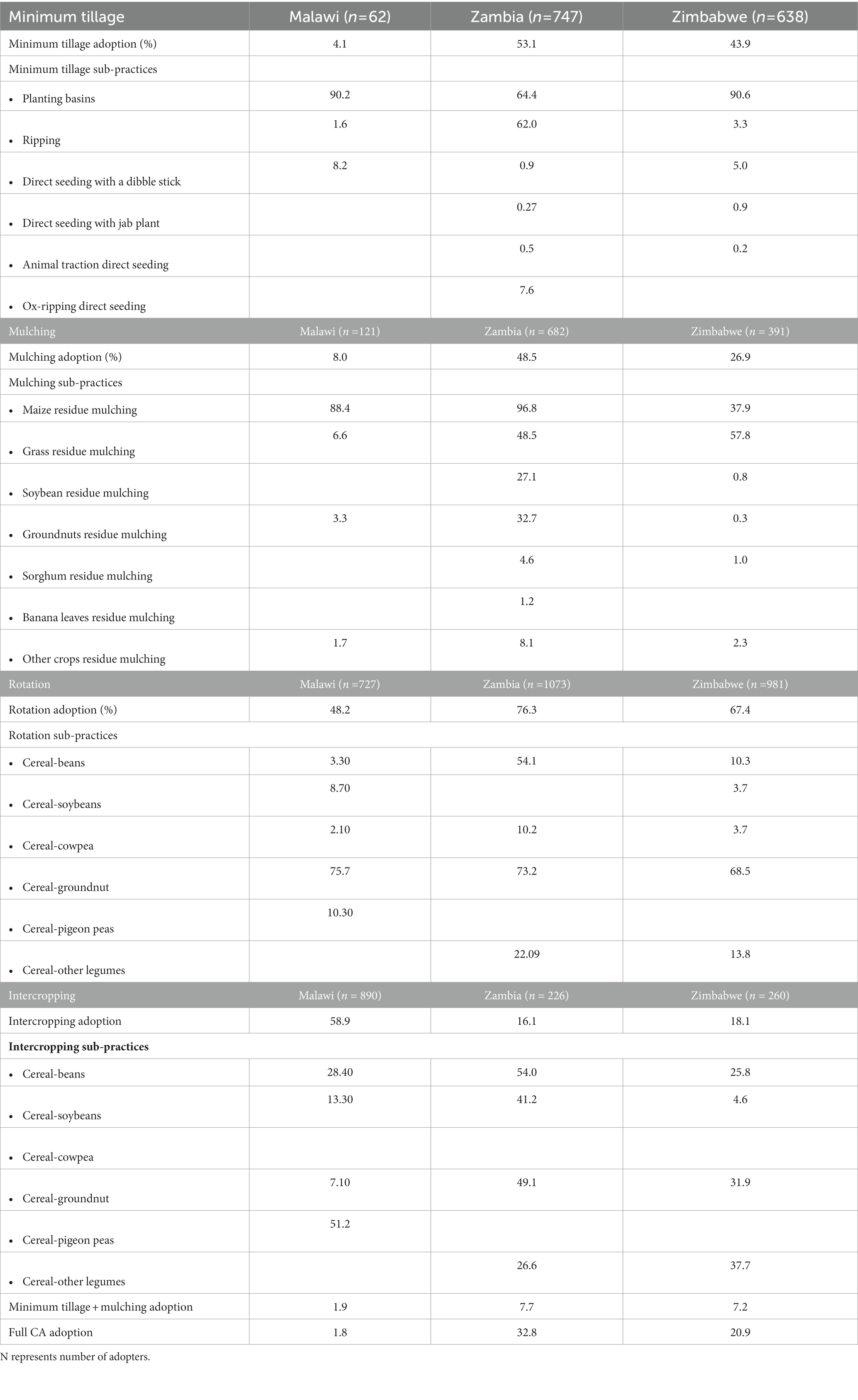
Table 9. Adoption of CA practices by country (multiple responses within a component in % of households).
An assessment of adoption of the various CA subcomponent practices shows that planting basins are the main minimum tillage practice in all countries. Most households reported adopting planting basins in Zimbabwe (91%) and Malawi (90%). Planting basins and ripping are equally important in Zambia (64 and 62%).4 From mulching subcomponents, maize residue mulching is common in Zambia (97%) and Malawi (88%). Farmers also adopt grass residue mulching in Zimbabwe (58%) and Zambia (49%). Results also show that Zambia has diversified mulching materials, including groundnut residues (33%) and soybean residues (27%). Diversification of mulching material is important because most smallholder maize plots hardly produce enough maize crop residues to cover at least 30% of their fields, the standard level to qualify as mulching. The typical crop rotation practice for all three countries is cereal-groundnut rotation, with over 68% of the households, and the common intercropped legumes are common beans, groundnut, and soybeans.
A comparison of awareness and adoption rates of CA practices (Figure 5) shows a wide gap between awareness and adoption for all CA practices. The gaps are wider for minimum tillage and crop residue mulching in Malawi, suggesting that much of the awareness of CA practices has not translated to adoption. Thus, there is a need for alternative and practical extension models in bridging the knowledge gap regarding CA practices in these countries.
Disadoption of CA practices is one of the challenges facing CA promotion efforts. Table 10 presents dis-adoption rates of CA practices by country. Malawi showed high dis-adoption rates for minimum tillage (60%) and mulching (58%). For all CA practices, the disadoption rates are low in Zimbabwe (less than 10%) and about a quarter in Zambia. The observed dis-adoption rates for crop rotation and intercropping are low as these are traditional practices. A qualitative assessment of farmers’ perceptions about the reasons for the dis-adoption of CA practices in Malawi shows the labor-intensive nature associated w+ith CA practices (35%), pests and diseases infestation (25%), and unavailability of crop residues (20%) as familiar major drivers to CA dis-adoption.
3.2.5. Perception of conservation agriculture practices
Farmers’ perception of new agricultural technologies is important in their decision to adopt (Mekonnen et al., 2018). Identifying misperceptions in new agricultural technologies is vital in determining how extension programs reduce knowledge gaps. Figure 6 presents households’ perceptions of new agricultural technologies in Malawi, Zambia, and Zimbabwe.
Results show that more than 80% of the households in Zambia and Zimbabwe and 68% in Malawi update themselves with current information on farming practices. Moreover, in all three countries, farming households perceive traditional practices as inferior and are willing to change their farming practices. However, over 65% of farmers are cautious in trying the new practices, and nearly 80% of the households in Malawi and Zimbabwe try out only promising practices. Besides, 58% of the households check out for favorable results from their neighbors’ fields before trying them out. These results call for the establishment of demonstration plots near farmers’ farm fields. Besides, there is a need for vibrant extension networks that work to showcase agricultural technologies in practice and enable farmers to evaluate the benefits of these technologies for increased CA adoption. Dalton et al. (2014) found similar results, i.e., farmers require tangible evidence before adopting technologies, and peer evidence is a vital source of information. As presented in 3.2.3 above, CA is knowledge-intensive, and demonstration plots provide the farmers a platform to learn by doing, where extension workers impart technical skills on CA application to farmers. Besides, most farmers who hosted the demonstration plots applied the same CA practice on their non-CA demonstration plots implying that CA demonstration plots are important in equipping smallholder farmers with the technical skills to implement CA.
3.2.6. Farmer assessment of the importance of technical, social, institutional, and economic factors in nonadoption and dis-adoption of CA practices
Figure 7 presents reasons for nonadoption and dis-adoption of CA practices among households that did not adopt or dis-adopted CA practices. Despite the high awareness of CA practices, more than 50% of nonadopter or dis-adopter households in Zimbabwe and around 70% of the households in Malawi and Zambia mentioned limited technical knowledge of CA practices as the main reason for nonadoption and dis-adoption of CA practices in all the countries. This could be because the CA promotion models widely used in the three countries – the lead farmers approach – is limited in transferring knowledge needed to practice CA. According to Friedrich et al. (2009), CA is a complex and management-intensive farming concept in which crop management must be planned proactively and not reactive, as in the standard tillage-based systems. Finance is another limiting factor for adoption of CA among smallholder farmers in all three countries. Thirty-one percent of the households in Zimbabwe, 48% in Malawi, and 72% in Zambia have indicated unavailability of credit to finance the purchase of inputs as a reason for nonadoption or disadoption of CA practices. Other reasons for disadoption of CA practices are poor access to extension, high cost of fertilizer, unavailability of legume seeds for intercropping/rotation, high labor costs at the time of planting, drudgery, unavailability of compatible herbicides, and weeds. Because CA does not provide immediate benefits and requires additional inputs, there is a need to support smallholder farmers, especially in the initial years, through different mechanisms to promote adoption of CA. Households also mentioned the limited availability of crop residues because of free grazing and uncontrolled wildfires suggesting a need for local-level institutional bylaws to protect crop residues from free grazing and fire.
3.2.7. Determinants of adoption of CA practice
Table 11 shows the likelihood ratio test results of the null hypothesis of independent error terms of the four equations (minimum tillage, mulching, intercropping, and crop rotation) that rejects the hypothesis. The pairwise correlations between the coefficients of the error terms are significant for all pairs in Zambia and Zimbabwe and 67% of pairs in Malawi. These results imply that the probability of adopting one of the CA practices is not independent of the decision to adopt other CA practices and thus justifies our choice of the MVP model instead of the univariate probit model. The positive sign of the coefficients shows the complementarity of the CA components. This assumption was informed by the fact that CA components are complementary. The qualitative assessment also indicated that farmers prefer a combination of CA components, particularly full CA, due to the maximum yield benefits of full CA instead of using a single CA component. Positive correlations also proved the assumption among the error terms for various CA components (equations).
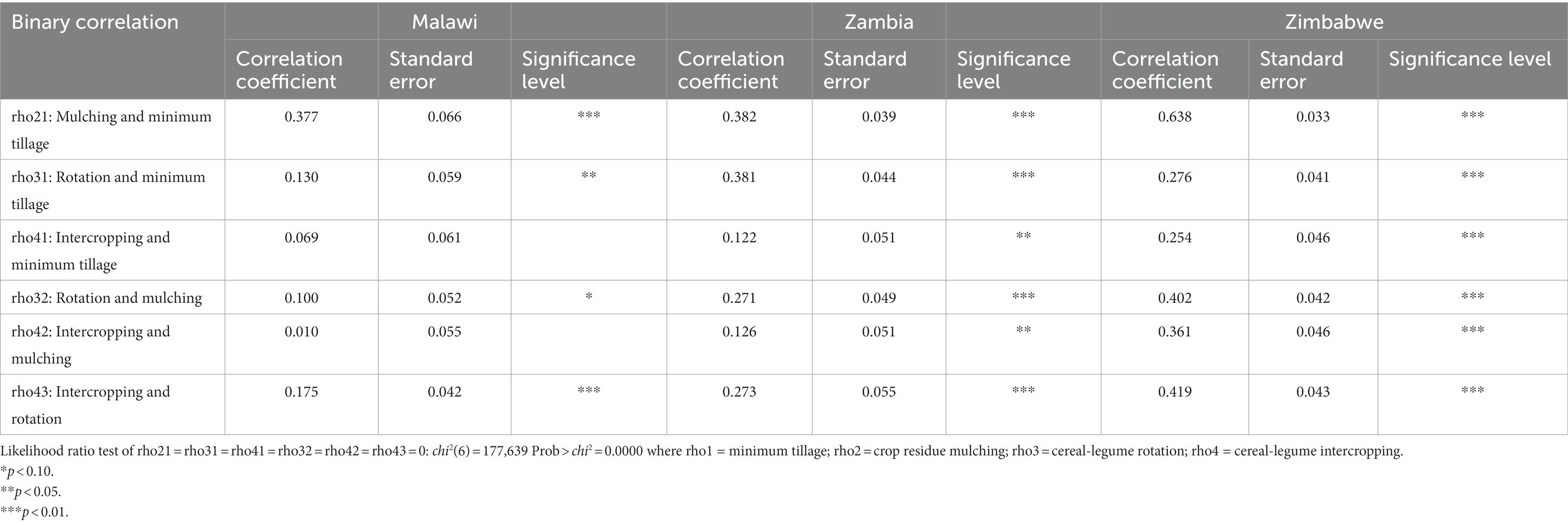
Table 11. Correlation coefficients of error terms obtained from multivariate probit model estimation.
Table 12 presents the results of the MVP model for the four CA practices in the three countries. The results show that the gender of the household head positively and significantly influenced crop rotation and intercropping adoption in Malawi and mulching in Zimbabwe. The implication is that female household heads are more likely to adopt crop rotation, intercropping, and mulching in the two countries. The adoption of intercropping could be related to female preferences for producing diverse crops for home consumption (Croppenstedt et al., 2013) or a function of their socially assigned roles as food crop producers. More specifically, female farmers are more involved in producing legumes as food and nutrition security crops, while male farmers grow cash crops such as tobacco. On the other hand, the positive effect of gender on the adoption of mulching may be influenced by the fact that mulching is relatively less labor-intensive as it eliminates the need for weeding. Thus, female farmers are more likely attracted to it than minimum tillage, which is considered more labor-intensive.
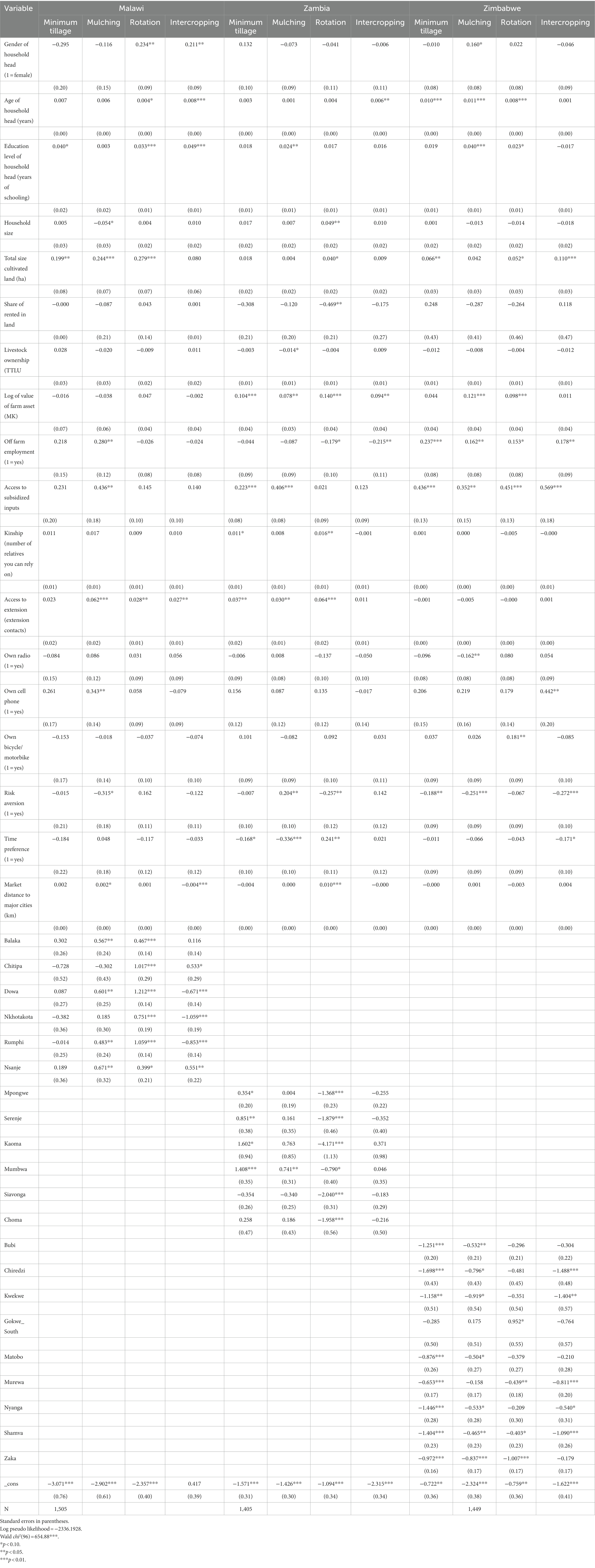
Table 12. Determinants of Adoption of CA practices: results of multivariate probit model estimation by country.
The age of the household head has positively and significantly influenced crop rotation adoption in Malawi and Zimbabwe, intercropping in Malawi and Zambia, and minimum tillage and mulching in Zimbabwe. The results align with previous studies (Ngoma et al., 2021). Ngoma et al. (2021) noted that CA elements such as rotations and intercropping are old-age practices prevalent in conventional farming. Older farmers are more likely to adopt these than young farmers. The significant effect of the age of the household on the adoption of minimum and mulching in Zimbabwe may be due to a relatively long history of CA promotion relative to the two countries. The household head’s education also influences the adoption of crop rotation in Malawi and Zimbabwe, minimum tillage and intercropping in Malawi, and mulching in Zambia and Zimbabwe. The findings also agree with the results by (Khonje et al., 2018), who found a positive effect of education on adopting multiple agricultural technologies in Eastern Zambia. Education level increases the capacity and speed of processing CA information (Kotu et al., 2017). The higher the education level, the greater the awareness and subsequent change in attitude and practice. Because CA is complex and knowledge-intensive, it requires more careful planning than standard tillage (Congress et al., 2010).
The size of total cultivated land influenced the adoption of minimum tillage in Malawi and Zimbabwe; mulching in Malawi, crop rotation in Malawi, Zambia, and Zimbabwe; and intercropping in Zimbabwe. These results align with the study conducted in Eastern and Southern Africa (Ngoma et al., 2021). Ngoma et al. (2021) note that larger landholding sizes allow farmers to experiment with CA on some parts of their land while maintaining the low-risk and low-return conventional farming methods. Livestock ownership measured as total livestock units (TLU) has a negative and statistically significant coefficient for mulching in Zambia, indicating that households who own more livestock, especially cattle (free grazers), are less likely to adopt mulching. The fact that livestock competes for crop residues in the form of feed contributes to limited crop residues left for mulching—a lack of supportive institutional bylaws regarding free grazing and wildfires in the study areas.
The value of farm assets has a statistically significant effect on adopting all four CA practices in Zambia and all practices except minimum tillage in Zimbabwe. The value of farm assets reflects the importance of the wealth of households and implies that wealthier households are more likely to adopt CA practices. Dalton et al. (2014) observe limited economic incentives contributing to the limited adoption of conservation practices globally. Access to subsidized inputs influences the adoption of minimum tillage (Zambia and Zimbabwe), mulching (all three countries), and intercropping in Zimbabwe, implying that households with access to subsidized inputs like fertilizer, seeds, and herbicides are more likely to adopt these CA practices. The limited access to farm inputs caused by liquidity constraints was among the major drivers of CA nonadoption and disadoption, according to the focus groups in Malawi and Zambia. Limited access to inputs is one of the technical factors limiting the adoption of CA practices such as minimum tillage and mulching (Friedrich et al., 2009).
Access to extension measured by the number of extension contacts per season positively and significantly influences adopting all CA practices except minimum tillage in Malawi and all the practices except intercropping in Zambia. This implies that households with more extension contacts per season are more likely to adopt mulching. We suggest that the insignificant effect of extension contact on minimum tillage may be explained by the quality of extension advice (technical details) rendered to farmers regarding the proper application of minimum tillage principles. Key informant interviews with some of the extension workers in Malawi revealed knowledge deficiencies about correct CA applications. This finding agrees with findings from FGD, where farmers cited limited access to extension as one of the major factors constraining the Adoption of CA practices.
The study also investigated the effect of other farmer characteristics/attributes that may affect CA adoption, such as attitude toward risk. Risk aversion was negatively and significantly correlated with adopting MT in Zimbabwe, mulching in Malawi, Zambia, and Zimbabwe, and intercropping in Zimbabwe. This suggests that risk-averse farmers are less likely to adopt CA practices. This finding confirms the results on farmer perceptions of CA practices where the majority of the farmers (nearly 80%) in Malawi and Zimbabwe only try out promising practices, and 58% of farmers from these countries check out for results from their neighbors’ fields before trying out the new agricultural techniques.
4. Conclusions and implications
This study aimed to understand the drivers and barriers to adopting CA practices using data from 278 focus groups and 4,374 smallholders in Malawi, Zambia, and Zimbabwe. The FGDs and the household surveys show that the main constraints to crop production are declining soil fertility, drought/heat, and pests and diseases in the three countries. From the results of the focus groups, using CA practices such as crop residue retention, minimum tillage, crop rotation, and intercropping could reduce the effects of declining soil fertility and drought through conserving moisture, biofertilization, and changing soil properties. However, most focus groups, mostly women, perceive that using CA practices does not help reduce the effects of pests and diseases.
The assessment of awareness of and preference for CA practices shows very high awareness of CA practices but generally low adoption, as observed by several studies in the literature. The gaps are much more significant between awareness and adoption, and much smaller between hosting demonstrations and adoption. The results suggest that much of the awareness of CA practices has not translated to greater adoption, pointing to the need for more technical knowledge regarding CA application rather than mere CA awareness. CA training and demos are better conduits to enhance adoption than awareness creation per se. Hosting demonstrations enhanced adoption of CA as most households that hosted the demonstrations also applied the same on their non-demonstration plots. This suggests that demonstrating the applications and benefits of CA practices is critical for promoting the adoption of CA practices in all countries.
Men and women focus groups in Malawi and Zambia, and women focus groups in Zimbabwe prefer full CA. The justification by the focus groups for selecting full CA is its ability to increase crop yields. In Zimbabwe, men focus groups chose a combination of minimum tillage and cereal legume rotation or intercropping because the use of legumes hedges against crop failure, especially maize. However, adoption of CA practices is low even in CA-prevalent districts in three countries, especially Malawi. In Malawi, the major reasons for farmers not to adopt or dis-adopt CA practices, according to sample households, are limited technical knowledge and limited assistance from extension workers, followed by the unavailability and high costs of inputs. However, focus groups show that the main barriers to adopting CA practices are lack of interest/incentive and labor intensity, limited technical knowledge, and crop residue-related problems.
In Zambia, lack of credit to purchase inputs, limited technical knowledge, high fertilizer cost, high labor cost during planting, and unavailability of legume seeds are among the reasons for not adopting or disadopting CA practices. According to focus groups in Zambia, farmers do not adopt or dis-adopt CA practice mainly because of limited access to inputs and labor intensity, followed by limited technical knowledge and labor intensity. In Zimbabwe, limited technical knowledge is the major factor for not adopting or dis-adopting CA practices, followed by labor intensity according to the sample households; and labor intensity according to focus groups. Limited technical knowledge, limited access to credit, poor access to extension, high cost of fertilizers, unavailability of legume seeds for intercropping/rotation, high costs of labor at the time of planting, drudgery, unavailability of compatible herbicides, and increased weed pressure at the early stage of CA adoption are the main reasons for nonadoption and dis-adoption of CA practices in the three countries.
The adoption rates of CA components and full CA is highest in Zambia and Zimbabwe for most CA practices. The high adoption rates of CA practices in Zambia and Zimbabwe are due to high past and present investments in CA promotion in the study areas. In Zambia and Zimbabwe, the dis-adoption rates are less than the adoption rates for all CA practices. However, in Malawi, the dis-adoption rates are greater than the adoption rates for minimum tillage and mulching.
The results of multivariate Probit (MVP) regression analyses for the four CA practices show that female farmers are more likely to adopt crop rotation and intercropping in Malawi and mulching in Zimbabwe. The age of the household head positively and significantly influenced crop rotation adoption in Malawi and Zimbabwe, intercropping in Malawi and Zambia, and minimum tillage and mulching in Zimbabwe. The education level of the household head positively influenced adoption of minimum tillage, rotation, and intercropping in Malawi, mulching in Zambia, and mulching and rotation in Zimbabwe. Total cultivated land size significantly influenced the adoption of minimum tillage, mulching, and crop rotation in Malawi; only rotation in Zambia; minimum tillage and rotation/intercropping in Zimbabwe.
The findings generally suggest an affordable supply of physical and financial inputs and the establishment of demonstration plots near farmer fields. More specifically, there is a need for investments in a dense network of highly visible and accessible community learning centers and vibrant extension networks for CA. Besides, most of the current investments in CA promotion are short-term, and there is a need for long-term on-farm demonstrations to enable farmers to understand and appreciate the benefits of CA. There is also a need to develop integrated weed management systems adapted to smallholder farming conditions. Thus, our study contributes to the recommendation in literature (e.g., Mafongoya et al., 2016) about the need to profile the technology, the farmers’ socioeconomic circumstances, and the bio-physical environment in which the farmer operates for proper agroecological and beneficiary targeting to achieve more significant impact at scale.
Data availability statement
The raw data supporting the conclusions of this article will be made available by the authors, without undue reservation.
Author contributions
All authors listed have made a substantial, direct, and intellectual contribution to the work and approved it for publication.
Acknowledgments
We thank the Royal Norwegian Government through the Norwegian Agency for Development Cooperation (NORAD) for funding this study through the Research Program on Climate Change, Agriculture and Food Security (CCAFS). We also acknowledge the Conservation Farming Unit (CFU) and the District Agricultural Coordinators (DACO) in the study districts in Zambia, the Departments of Land Resources Conservation (DLRC), the Department of Agricultural Extension Services (DAES), District Agricultural Development Office (DADO) in Malawi and the Department of Agricultural, Technical and Extension Services (AGRITEX) both at the headquarters and district staff in all the 10 districts covered in this study and the CA Task Force in Zimbabwe. We are grateful to several people, too numerous to name, who were part of the survey teams in the three countries.
Conflict of interest
The authors declare that the research was conducted in the absence of any commercial or financial relationships that could be construed as a potential conflict of interest.
Publisher’s note
All claims expressed in this article are solely those of the authors and do not necessarily represent those of their affiliated organizations, or those of the publisher, the editors and the reviewers. Any product that may be evaluated in this article, or claim that may be made by its manufacturer, is not guaranteed or endorsed by the publisher.
Footnotes
1. ^CA is a farming method based on (a) minimal mechanical soil disturbance, (b) permanent organic soil cover by crop residues and cover crops, and (c) diversified crop rotations or associations with legumes. As such it removes the components of conventional agricultural systems that lead to soil and land degradation.
2. ^In this study, awareness of CA is defined as "having heard about CA practices" while "knowledge of CA" refers to "having technical knowledge to apply CA to crop fields."
3. ^We consider minimum tillage as the main component of CA as it is the foundation for applying the remain two components or principles. Besides, literature such as (Ngoma et al., 2021) and other donors consider minimum tillage as the main CA component. This is so because CA focuses on reduced soil disturbance where tillage is done only in planting stations and the rest of the soil is left undisturbed. Ngoma et al. (2021) note that MT is the most prevalent and nonnegotiable CA component.
4. ^This may be attributed to relatively high prevalence of Magoye ripper in Zambia (Arslan et al., 2014; Tambo and Kirui, 2021). A Magoye ripper is a farm mechanization machinery that is used to open up planting furrows leaving the soil of the other part of the field undisturbed. It is usually ox-drawn in Zambia. It is used to addresses the drudgery associated with minimum tillage-based practices. The furrows improve water infiltration and harvest water that will be made available to the plant.
References
Abdulai, A. N. (2016). Impact of conservation agriculture technology on household welfare in Zambia. Agric. Eco. 47, 729–741. doi: 10.1111/agec.12269
Abdulai, A. N., and Abdulai, A. (2017). Examining the impact of conservation agriculture on environmental efficiency among maize farmers in Zambia. Environ. Dev. Econ. 22, 177–201. doi: 10.1017/S1355770X16000309
Arslan, A., McCarthy, N., Lipper, L., Asfaw, S., and Cattaneo, A. (2014). Adoption and intensity of adoption of conservation farming practices in Zambia. Agric. Ecosyst. Environ. 187, 72–86. doi: 10.1016/j.agee.2013.08.017
Belderbos, R., Carree, M., Diederen, B., Lokshin, B., and Veugelers, R. (2004). Heterogeneity in R&D cooperation strategies. Int. J. Ind. Organ. 22, 1237–1263. doi: 10.1016/j.ijindorg.2004.08.001
Brown, B., Nuberg, I., and Llewellyn, R. (2017). Negative evaluation of conservation agriculture: perspectives from African smallholder farmers. Int. J. Agric. Sustain. 15, 467–481. doi: 10.1080/14735903.2017.1336051
Cairns, J. E., Sonder, K., Zaidi, P. H., Verhulst, N., Mahuku, G., Babu, R., et al. (2012). Maize production in a changing climate. Impacts, adaptation, and mitigation strategies. Adv. Agron. 114, 1–58. doi: 10.1016/B978-0-12-394275-3.00006-7
Cappellari, L., and Jenkins, S. P. (2003). Multivariate Probit regression using simulated maximum likelihood. Stata J. 3, 278–294. doi: 10.1177/1536867x0300300305
Chinseu, E., Dougill, A., and Stringer, L. (2019). Why do smallholder farmers dis-adopt conservation agriculture? Insights from Malawi. Land Degrad. Dev. 30, 533–543. doi: 10.1002/ldr.3190
Congress, I., Derpsch, R., Friedrich, T., Consultant, I., and Sol, S. (2010). The adoption of conservation agriculture worldwide. ISCO Congress, 8–12.
Croppenstedt, A., Goldstein, M., and Rosas, N. (2013). Gender and agriculture: inefficiencies, segregation, and low productivity traps. World Bank Res. Obs. 28, 79–109. doi: 10.1093/wbro/lks024
Dalton, T. J., Yahaya, I., and Naab, J. (2014). Perceptions and performance of conservation agriculture practices in northwestern Ghana. Agriculture, Ecosystems and Environment 187, 65–71. doi: 10.1016/j.agee.2013.11.015
Fisher, M., Holden, S. T., Thierfelder, C., and Katengeza, S. P. (2018). Awareness and adoption of conservation agriculture in Malawi: what difference can farmer-to-farmer extension make? Int. J. Agric. Sustain. 16, 310–325. doi: 10.1080/14735903.2018.1472411
Foster, A. D., and Rosenzweig, M. R. (2010). Microeconomics of technology adoption. Ann. Rev. Eco. 2, 395–424. doi: 10.1146/annurev.economics.102308.124433
Friedrich, T., Kienzle, J., and Kassam, A. (2009). Conservation agriculture in developing countries: the role of mechanization. Innovation for Sustainable Agricultural Mechanisation Club, July 2008, 20.
Giller, K. E., Andersson, J. A., Corbeels, M., Kirkegaard, J., Mortensen, D., Erenstein, O., et al. (2015). Beyond conservation agriculture. Front. Plant Sci. 6, 1–14. doi: 10.3389/fpls.2015.00870
Gillespie, J. M., Davis, C. G., and Rahelizatovo, N. C. (2004). Factors influencing the adoption of breeding technologies in U.S. hog production. J. Agric. Appl. Econ. 36, 35–47. doi: 10.1017/s1074070800021842
Grabowski, P. P., Kerr, J. M., Haggblade, S., and Kabwe, S. (2016). Determinants of adoption and disadoption of minimum tillage by cotton farmers in eastern Zambia. Agric. Ecosyst. Environ. 231, 54–67. doi: 10.1016/j.agee.2016.06.027
Hermans, T. D. G., Whitfield, S., Dougill, A. J., and Thierfelder, C. (2020). Bridging the disciplinary gap in conservation agriculture research, in Malawi. A review. Agron. Sustain. Dev. 40, 1–15. doi: 10.1007/s13593-020-0608-9
Holden, S. T., Fisher, M., Katengeza, S. P., and Thierfelder, C. (2018). Can lead farmers reveal the adoption potential of conservation agriculture? The case of Malawi. Land Use Policy 76, 113–123. doi: 10.1016/j.landusepol.2018.04.048
Jew, E. K. K., Whitfield, S., Dougill, A. J., Mkwambisi, D. D., and Steward, P. (2020). Farming systems and conservation agriculture: technology, structures and agency in Malawi. Land Use Policy 95:104612. doi: 10.1016/j.landusepol.2020.104612
Kassam, A., Friedrich, T., Shaxson, F., Bartz, H., Mello, I., Kienzle, J., et al. (2014). The spread of conservation agriculture: policy and institutional support for adoption and uptake. Field Act. Sci. Rep. 7, 01–12.
Khanna, M. (2001). Sequential adoption of site-specific technologies and its implications for nitrogen productivity: a double selectivity model. Agric. Econ. 83, 35–51. doi: 10.1111/0002-9092.00135
Khonje, M. G., Manda, J., Mkandawire, P., Tufa, A. H., and Alene, A. D. (2018). Adoption and welfare impacts of multiple agricultural technologies: evidence from eastern Zambia. Agric. Eco. 49, 599–609. doi: 10.1111/agec.12445
Kotu, B. H., Alene, A., Manyong, V., Hoeschle-Zeledon, I., and Larbi, A. (2017). Adoption and impacts of sustainable intensification practices in Ghana. Int. J. Agric. Sustain. 15, 539–554. doi: 10.1080/14735903.2017.1369619
Lee, M., and Gambiza, J. (2022). The adoption of conservation agriculture by smallholder farmers in southern Africa: a scoping review of barriers and enablers. J. Rural. Stud. 92, 214–225. doi: 10.1016/j.jrurstud.2022.03.031
Lobell, D. B., Burke, M. B., Tebaldi, C., Mastrandrea, M. D., Falcon, W. P., and Naylor, R. L. (2008). Prioritizing climate change adaptation needs for food security in 2030. Science 319, 607–610. doi: 10.1126/science.1152339
Madembo, C., Mhlanga, B., and Thierfelder, C. (2020). Productivity or stability? Exploring maize-legume intercropping strategies for smallholder conservation agriculture farmers in Zimbabwe. Agric. Syst. 185:102921. doi: 10.1016/j.agsy.2020.102921
Mafongoya, P., Rusinamhodzi, L., Siziba, S., Thierfelder, C., Mvumi, B. M., Nhau, B., et al. (2016). Maize productivity and profitability in conservation agriculture systems across agro-ecological regions in Zimbabwe: a review of knowledge and practice. Agric. Ecosyst. Environ. 220, 211–225. doi: 10.1016/j.agee.2016.01.017
Marongwe, L. S., Kwazira, K., Jenrich, M., Thierfelder, C., Kassam, A., and Friedrich, T. (2011). An African success: the case of conservation agriculture in Zimbabwe. Int. J. Agric. Sustain. 9, 153–161. doi: 10.3763/ijas.2010.0556
Mazvimavi, K., and Twomlow, S. (2009). Socioeconomic and institutional factors influencing adoption of conservation farming by vulnerable households in Zimbabwe. Agric. Syst. 101, 20–29. doi: 10.1016/j.agsy.2009.02.002
Mekonnen, Z., Kassa, H., Woldeamanuel, T., and Asfaw, Z. (2018). Analysis of observed and perceived climate change and variability in Arsi Negele District, Ethiopia. Environ. Dev. Sustain. 20, 1191–1212. doi: 10.1007/s10668-017-9934-8
Ndiritu, S. W., Kassie, M., and Shiferaw, B. (2014). Are there systematic gender differences in the adoption of sustainable agricultural intensification practices? Evidence from Kenya. Food Policy 49, 117–127. doi: 10.1016/j.foodpol.2014.06.010
Ng’ombe, J. N., Kalinda, T. H., and Tembo, G. (2017). Does adoption of conservation farming practices result in increased crop revenue? Evidence from Zambia. Agrekon 56, 205–221. doi: 10.1080/03031853.2017.1312467
Ngoma, H., Angelsen, A., Jayne, T. S., and Chapoto, A. (2021). Understanding adoption and impacts of conservation agriculture in eastern and southern Africa: a review. Front. Agron. 3, 1–12. doi: 10.3389/fagro.2021.671690
Ngoma, H., Mulenga, B., and Jayne, T. (2016). Minimum tillage uptake and uptake intensity by smallholder farmers in Zambia. Afr. J. Agric. Resour. Eco. 11, 249–262. doi: 10.22004/ag.econ.252456
Ngwira, A., Johnsen, F. H., Aune, J. B., Mekuria, M., and Thierfelder, C. (2014). Adoption and extent of conservation agriculture practices among smallholder farmers in Malawi. J. Soil Water Conserv. 69, 107–119. doi: 10.2489/jswc.69.2.107
Omuto, C. T., and Vargas, R. (2018). Soil nutrient loss assessment in Malawi. Technical Report. FAO, UNEP and UNDP, 1–64.
Pedzisa, T., Rugube, L., Winter-Nelson, A., Baylis, K., and Mazvimavi, K. (2015a). Abandonment of conservation agriculture by smallholder farmers in Zimbabwe. J. Sustain. Develop. 8, 69–82. doi: 10.5539/jsd.v8n1p69
Pedzisa, T., Rugube, L., Winter-Nelson, A., Baylis, K., and Mazvimavi, K. (2015b). The intensity of adoption of conservation agriculture by smallholder farmers in Zimbabwe. Agrekon 54, 1–22. doi: 10.1080/03031853.2015.1084939
Sanginga, N., and Woomer, P. L. (2009). “Integrated soil fertility Management in Africa: principles practices and development process.” in Tropical soil biology and fertility Institute of the International Centre for tropical agriculture. Nairobi.
Tambo, J. A., and Kirui, O. K. (2021). Yield effects of conservation farming practices under fall armyworm stress: the case of Zambia. Agric. Ecosyst. Environ. 321:107618. doi: 10.1016/j.agee.2021.107618
TerAvest, D., Wandschneider, P. R., Thierfelder, C., and Reganold, J. P. (2019). Diversifying conservation agriculture and conventional tillage cropping systems to improve the wellbeing of smallholder farmers in Malawi. Agric. Syst. 171, 23–35. doi: 10.1016/j.agsy.2019.01.004
Thierfelder, C., Chivenge, P., Mupangwa, W., Rosenstock, T. S., Lamanna, C., and Eyre, J. X. (2017). How climate-smart is conservation agriculture (CA)? – its potential to deliver on adaptation, mitigation and productivity on smallholder farms in southern Africa. Food Secur. 9, 537–560. doi: 10.1007/s12571-017-0665-3
Whitfield, S., Dougill, A. J., Dyer, J. C., Kalaba, F. K., Leventon, J., and Stringer, L. C. (2015). Critical reflection on knowledge and narratives of conservation agriculture. Geoforum 60, 133–142. doi: 10.1016/j.geoforum.2015.01.016
Keywords: conservation agriculture, climate change, climate adaptation, adoption, focus group discussion, Malawi, Zambia, Zimbabwe
Citation: Tufa AH, Kanyamuka JS, Alene A, Ngoma H, Marenya PP, Thierfelder C, Banda H and Chikoye D (2023) Analysis of adoption of conservation agriculture practices in southern Africa: mixed-methods approach. Front. Sustain. Food Syst. 7:1151876. doi: 10.3389/fsufs.2023.1151876
Edited by:
Francis Tetteh, Council for Scientific and Industrial Research (CSIR), GhanaReviewed by:
John N. Ng'ombe, North Carolina Agricultural and Technical State University, United StatesNester Mashingaidze, One Acre Fund, Rwanda
Copyright © 2023 Tufa, Kanyamuka, Alene, Ngoma, Marenya, Thierfelder, Banda and Chikoye. This is an open-access article distributed under the terms of the Creative Commons Attribution License (CC BY). The use, distribution or reproduction in other forums is permitted, provided the original author(s) and the copyright owner(s) are credited and that the original publication in this journal is cited, in accordance with accepted academic practice. No use, distribution or reproduction is permitted which does not comply with these terms.
*Correspondence: Adane H. Tufa, YS50dWZhQGNnaWFyLm9yZw==
†These authors have contributed equally to this work and share first authorship
 Adane H. Tufa
Adane H. Tufa Joseph S. Kanyamuka1†
Joseph S. Kanyamuka1† Arega Alene
Arega Alene Paswel P. Marenya
Paswel P. Marenya Christian Thierfelder
Christian Thierfelder David Chikoye
David Chikoye